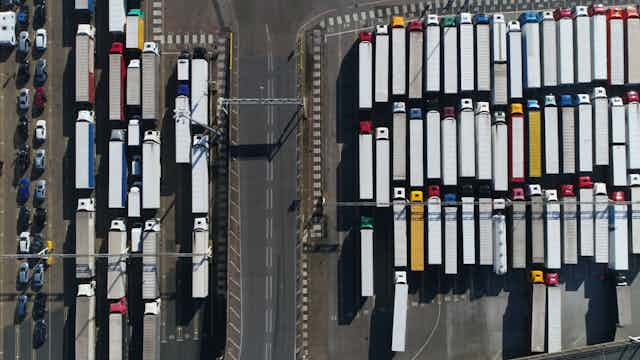Theresa May’s Chequers plan for the UK’s post-Brexit relationship with the EU received a pretty brutal rejection at an informal meeting of EU leaders in Salzburg in mid-September.
Reports of its demise have revived feverish talk about an alternative “Canada-plus agreement” that would go further than the EU’s current deal with Canada. Some Brexiters have thrown their support behind a policy paper from the Institute for Economic Affairs, which makes the case for such an approach. May insists a Canada-plus arrangement would be worse than a no-deal scenario.
Both Chequers and Canada-plus propose zero tariffs on all goods traded between the UK and the EU and ostensibly leave the UK free to pursue its own trade policies with other countries. Chequers, however, aims to levy EU tariffs on any goods entering the UK that will ultimately end up in the EU. The general assumption is that after Brexit the UK will lower its tariffs below EU levels either in general or for particular partner countries in free trade agreements.
From what is known so far, it’s possible to highlight seven likely differences as far as trade in goods is concerned.
Read more: Chequers plan: why Theresa May’s Brexit blueprint is not quite dead
1. Rules of Origin on the EU-UK border
Rules of Origin (ROOs) are used in free trade agreements to define which goods can be exported to the partner country tariff-free and which cannot. Trade flows more freely if there are no ROOs because no effort is required to prove origin and there is no danger of goods being charged the tariff because they do not meet the rules.
In a Chequers deal, ROOs are not required because anything going to the EU via Britain will already have paid the EU tariff.
In a Canada-plus agreement, they would be necessary because if there were no ROOs, exporters could send their goods to the UK with its lower tariffs, and then transport them tariff-free to the EU, undermining the latter’s tariffs.
2. Tracking imported goods within the UK
A Chequers style agreement would require imports into the UK from non-EU sources to be tracked to ensure that importers pay the right tariff. If it’s not clear at the moment a good is imported whether it will be consumed in the UK or the EU, importers must pay the higher EU tariff. The importer can then claim a rebate to the lower UK rate if it can prove (by post-import tracking) that the good has remained in the UK.

A UK government White Paper published in July on the Chequers proposals implies that little trade will need tracking – 16% of non-EU imports. That is an underestimate because it assumes that it will always be clear on entry to the UK whether a final good will end up in the UK or in the EU, whereas in fact in plenty of cases that will only be known later.
In a Canada-plus deal, tracking would not be necessary. Goods pay the UK tariff on entering the UK and can be sold onto the EU tariff free if, and only if, they are incorporated into other goods that meet the EU’s rules of origin. Otherwise they pay the EU tariff on entering the EU.
3. Regulations checked on the border
In a Chequers deal, regulations checked on the border such as food standards (notorious chlorine-washed chicken, for example) will be harmonised with EU rules via a “common rule book”. This is to ensure there is no question of checking regulated goods, and hence disturbing their passage, as they pass between the UK and the EU.
The EU will want assurances that the UK really is obeying its rules even though it will be outside the jurisdiction of the European Court of Justice. The UK says it will voluntarily adhere to the court’s rulings. This means if a UK regulation governing a food standard is aligned with the EU’s, it will be next to impossible for the UK to sign a trade agreement with another country that deals with the same regulation.
In a Canada-plus agreement, there is no such commitment to harmonisation. Part of the “plus” in Canada-plus refers to the UK and the EU mutually recognising each other’s regulations. This would also eliminate the need for checking at the border. However, mutual recognition agreements are difficult and slow to negotiate and typically deal with only narrowly defined products. And they have to be renegotiated every time a regulation changes.

4. Regulations not checked at the border
Chequers offers little commitment about alignment on issues such as working conditions and environmental rules. But in a comprehensive agreement, the UK may choose to make some commitments.
In a Canada-plus deal, there is no need for alignment unless this is agreed in negotiations. Still, the EU may try to insist that the UK does not weaken its regulations and any UK reluctance to agree to this may result in fewer EU concessions in other areas.
5. Hard border in Ireland
Chequers is intended to obviate the need for a hard border between Northern Ireland and the Republic of Ireland, because goods will already have paid the appropriate tariff and will already satisfy all the regulations required to be allowed across the border.
Read more: Where the UK's Brexit plan (and Customs Bill) leave Northern Ireland
In a Canada-plus deal, a hard border is almost inevitable. Advocates of Canada-plus claim that technology can remove the need for a border, but the need for controls cannot be avoided even if they are positioned well inside the border. North-South trade in Ireland will inevitably be hindered.
6. Port congestion
Chequers aims to preserve the current free flow of trade between the UK and EU and so claims it will not add to congestion.
Even small amounts of additional border formality in a Canada-plus arrangement will create queues and uncertainty at ports used for UK-EU trade – most notably at Dover. Other ports may be used instead of Dover (after improvement), but only at extra cost and with longer journey times.
7. VAT
Chequers proposes that the UK will remain in the EU’s VAT system. The EU is very uncertain that it wants this and, so far as we know, there has been very little practical discussion so far.
Under a Canada-plus deal, the UK could seek to remain in the EU VAT system. However, with less cooperation than under Chequers, EU agreement to this is less likely. Besides, Canada-plus requires borders already, so administering VAT at the border is only a marginal issue.
What’s missing
Neither proposal deals with services or labour markets satisfactorily. On goods, Chequers is an awkward and expensive approach to UK-EU relations, and, while a simple free trade agreement such as Canada’s – even with some pluses – is much cleaner and logically coherent, it saddles UK-EU trade with costly formalities that will curtail UK-EU trade.
Overall, neither proposal is very attractive from an economic point of view.

